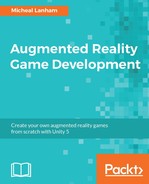At the beginning of 2016, most of the world had very little knowledge of augmented reality and location-based games. That, of course, all changed with the release of Pokemon Go later that year. Literally overnight, the genre became entrenched as an upcoming trend in game development. Chances are you have played Pokemon Go and the reason you are reading this book is because of your interest in the genre of AR and location-based games.
In this book we will explore in detail the aspects of creating a location-based AR game just like Pokemon Go. Location-based AR games are expensive and require multiple services for everything from mapping to spawning monsters. However, the game we develop will be done with zero budget using freely available services. While this may not be something you could release commercially, due to some licensing restrictions, it will certainly introduce you to most of the concepts. Along the way, you will also learn how to use a great tool, Unity, and introduce many other concepts in game development.
Chapter 1, Getting Started, introduces the concepts that make up the genre of location-based AR games and our fictional game, Foody Go. This will be followed by a walk-through of downloading all the required software and setting up your mobile development environment with Unity.
Chapter 2, Mapping the Player's Location, starts by introducing the fundamental concepts of GIS, GPS, and mapping. Then shows how those concepts are applied to generating a real-time map and plotting the player’s location in a game.
Chapter 3, Making the Avatar, builds on the previous chapter and transforms our simple location marker into a moving animated character. This allows the player to see their avatar move around the map as they move carrying their mobile device.
Chapter 4, Spawning the Catch, explains that the premise of Foody Go is about catching experimental monsters. In this chapters, we learn how to spawn the monsters around the player on the map.
Chapter 5, Catching the Prey in AR, ups the intensity by introducing integrated AR part of the game by accessing the device's camera, introduces physics for throwing balls, tracking player swiping, using creature reactions, and working with a new game scene.
Chapter 6, Storing the Catch, devoted to developing the player's inventory bag, which will hold all the Foody creatures they catch, and other useful items. Here, we walk the reader through adding persistent storage and adding a simple inventory scene.
Chapter 7, Creating the AR World, adds locations of interest around the player based on a real-time data service.
Chapter 8, Interacting with an AR World, allows the player to interact with the locations of interest. In our simple game, the player will be able to sell their caught monsters.
Chapter 9, Finishing the Game, provides the reader with the information on how to finish the game or better yet write their own location-based AR game. For the purposes of this book, we will only develop the demo Foody Go game.
Chapter 10, Troubleshooting, cover a number of troubleshooting tips and tricks to overcome those development obstacles. As with any software development exercise, problems always arise.
